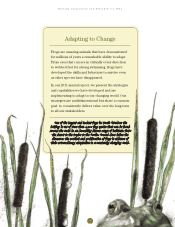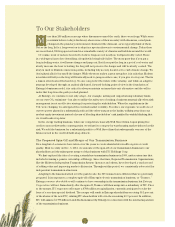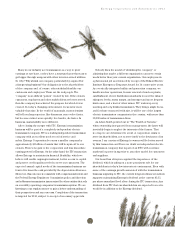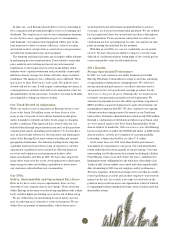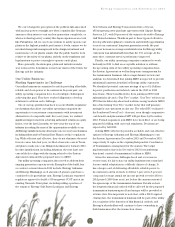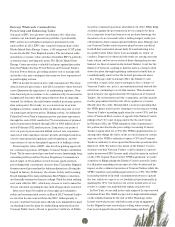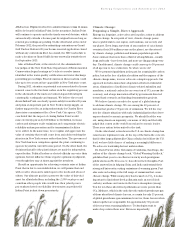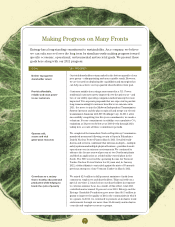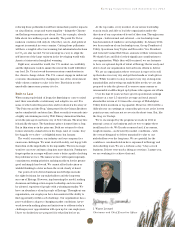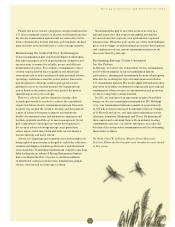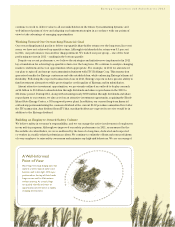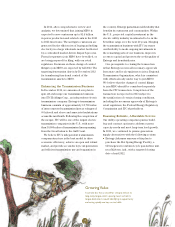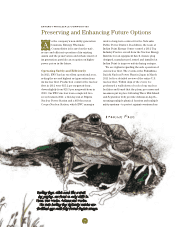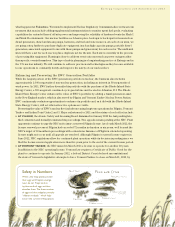Entergy 2011 Annual Report Download - page 13
Download and view the complete annual report
Please find page 13 of the 2011 Entergy annual report below. You can navigate through the pages in the report by either clicking on the pages listed below, or by using the keyword search tool below to find specific information within the annual report.
Finally, the move toward competitive energy markets in the
U.S. is increasing the number of players and transactions that
the electric transmission system must accommodate. In the
future envisioned by federal and state policymakers, the grid
must facilitate open and efficient access to energy markets.
Modernizing the Grid with New Technologies
Today’s transmission grid employs intelligent technologies
that asset managers as well as grid planners, designers and
operators use to ensure the reliable, secure and efficient
transmission of power. For example, transmission control
centers employ system data-acquisition and situational-
awareness tools to help operators identify potential adverse
operating conditions across the power system. Innovative
synchrophasor technology enables grid operators and
planners to more accurately measure the instantaneous
power flows on the system and better protect the system
against large-scale power outages.
However, research and development of many other
technologies would be needed to achieve the capabilities
required of future electric transmission systems. Research
is under way around the world to develop and demonstrate
a suite of advanced sensors to inspect and assess the
health of transmission line and substation equipment and
facilitate sophisticated life-cycle asset management. Novel
grid component technologies are under development in
the areas of advanced energy storage, next-generation
relays, superconducting cables and fault current limiters,
nanotechnology and many others.
Advanced computing and communication technologies are
being explored as an overlay to the grid to enable the collection,
analysis and display of system performance and situational-
awareness data. Transmission substations could become data
hubs feeding into an advanced Energy Management System
that coordinates the flow of power to and from millions
of distributed customer photovoltaic installations, plug-in
electric vehicles and local storage facilities.
Modernizing the grid to meet the needs of society is a
national imperative that requires thoughtful investment
in research and development, new systems and expanded
infrastructure. While the scale and scope of the undertaking is
great, it is no bigger an undertaking than was the development
and construction of our current transmission system in its
time more than 50 years ago.
Positioning Entergy Utility Customers
for the Future
At Entergy, we believe the independent electric transmission
model with its singular focus on transmission system
performance, planning and operations is the most advantageous
structure for realizing the type of transformation needed in
U.S. transmission systems. The model aligns with national policy
objectives to facilitate investment in regional and inter-regional
transmission, advances open access initiatives and promotes
access to competitive energy markets.
In 2011, we announced an agreement to spin off and then
merge our electric transmission business into ITC Holdings
Corp. Our transmission business consists of approximately
15,700 miles of interconnected transmission lines at voltages
of 69 kilovolt and above, and associated substations across
Arkansas, Louisiana, Mississippi and Texas. By spinning off
these assets and combining them with an industry-leading
transmission operator, our utility customers can realize the
benefits of the independent transmission model in addressing
these future realities.
We thank Clark W. Gellings, Electric Power Research
Institute Fellow for the thoughts and insights he contributed
to this essay.
Entergy Corporation and Subsidiaries 2011
11


